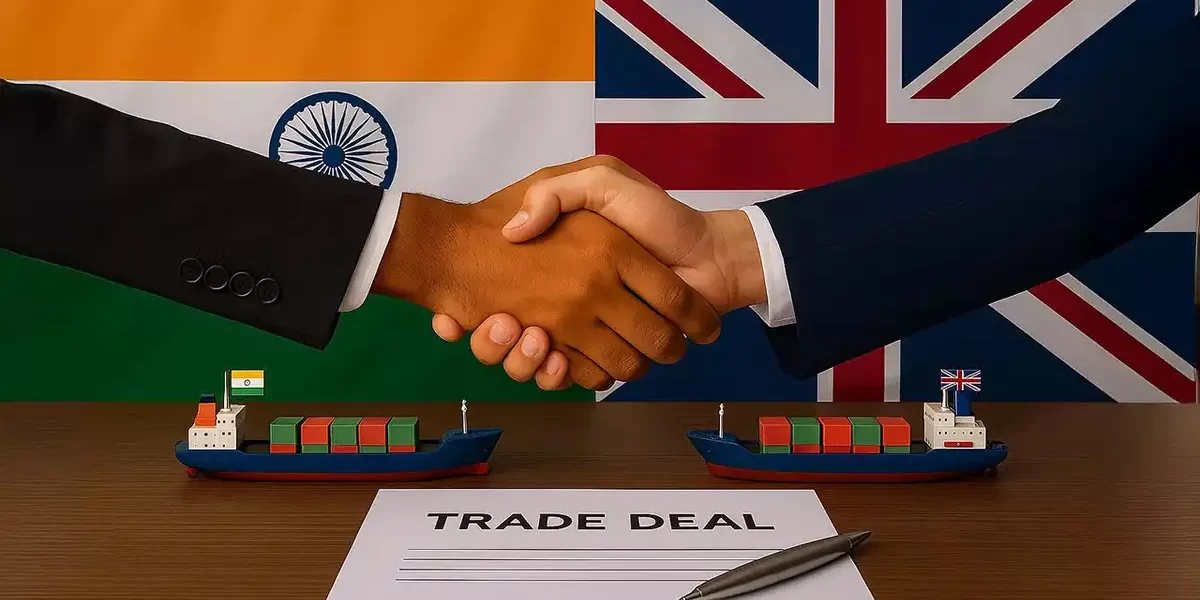Bharat and Britain signed a Free Trade Agreement (FTA) on 24th July during the Prime Minister Modi’s Visit to the UK. This trade deal is expected to boost annual bilateral trade by $ 34 billion. Officially, this trade deal is known as the Comprehensive Economic and Trade Agreement (CETA), which aims to boost bilateral trade and investment, with both countries targeting to double trade volume to over $100 billion by 2030 from the current $56 billion.
Under this Free Trade Agreement, Bharat will constantly reduce import duties on key UK exports such as Scotch whisky, gin, and automobiles. In return, Bharat will gain zero duty access for its labour-intensive exports, including textiles, leather, and footwear, key sectors that are expected to benefit from enhanced market access in the UK.
The Bharat-UK FTA is expected to offer economic gains of a generally broader nature, with probable expansion of trade in both goods and services. Apart from market access issues, the pact would envision facilitation of professional mobility, enhanced regulatory cooperation, and support for cross border investment. Bharat would look to increase exports and scale up the acceleration of growth in some big-ticket sectors while the UK gains an important entry into one of the fastest-growing consumer markets globally.
The Bharatiya market stands to benefit in a big way across various sectors under the Bharat–UK FTA. On the exports side, the tariff will be removed on most of the items such as textiles, apparel, gemstones and jewelry, leather, machinery, auto parts, pharmaceuticals, agricultural products, chemicals, processed foods, and marine products, boosting exports in these sectors by around 20-40 percent. This would greatly aid our manufacturing and exports domestically.
In terms of tariff benefits, nearly 99 percent of Bharatiya exports to the UK will now face zero or reduced tariffs, significantly improving Bharat’s competitive position against other export-driven countries like Bangladesh, Vietnam, and China. This preferential market access is likely to enhance Bharat’s export volumes to the UK in the coming years.
Regarding professional mobility, the FTA offers Bharatiyan professionals working in the UK visa relaxation, social security contribution waivers, and provisions for the mutual recognition of professional qualifications. According to estimates, these adjustments will increase employment and consulting opportunities for Bharatiyan engineers, IT specialists, and healthcare workers while also saving about ₹40 billion (roughly US$462.88 million).
In agriculture and food processing, over 95 percent of tariff lines in agricultural and processed food items will now attract zero duty. This move is set to benefit exports of basmati rice, spices, tea, seafood, and packaged food products, sectors where Bharat has a strong comparative advantage. Similarly, the marine and fisheries sector will enjoy duty-free access for 99 percent of Bharatiyan marine exports, such as shrimp and tuna. Although Bharat’s current share in UK marine imports is just 2.25 percent, the FTA opens a pathway for significant expansion.
In the area of green technology and energy, the FTA is expected to encourage UK investment in Bharat’s solar, hydrogen, battery storage, and electric vehicle infrastructure sectors, aligning with Bharat’s clean energy goals and energy security objectives.
Finally, the FTA also holds substantial strategic value, strengthening economic and geopolitical ties between Bharat and the UK at a time of shifting global alliances and trade realignments. The agreement signals a move towards a deeper, long-term bilateral partnership that goes beyond trade and enters the realm of strategic collaboration.
UK companies meeting a 20 percent domestic sourcing threshold will now be eligible to participate in Bharat’s government procurement market, which includes contracts for goods, services, and infrastructure. These firms will be treated as “Class II” local suppliers, on par with Bharatiyan bidders. This provision grants British companies access to the INR 4 trillion (US$46.288 billion) market and encourages joint ventures and hybrid supply chain models between Bharatiyan and UK businesses.
The Bharat–UK Free Trade Agreement also presents some challenges for Bharat in respect of increased access of British products into the Bharat market. While the majority of Bharatiya exports into the UK are already kept at low or zero tariffs, British imports, such as automobiles, Scotch whisky, and wines, are currently burdened with very high import tariffs of 100% to 150%. The phasing out of these tariffs under the FTA could lead to a vast quantity of British products into the Bharatiyan market, displacing domestic producers in areas such as automobiles, beverages, and luxury goods.
The difference is also evident in the average rates: Bharat imports to the UK pay a mere 4.2% average tariff, while UK imports to Bharat incur an average tax of 14.6%. With the FTA aiming to bridge the difference, there is fear that the UK exporters will be the gainers of the deal at the cost of making it harder for the local Bharatiyan industry to compete.
Besides tariff issues, a number of other major concerns are still unresolved or half resolved. They include intellectual property rights (IPRs), relating to Bharat’s generic drug sector. The social security arrangement, even being partly beneficial, continues to cause some uncertainty over long-term Bharatiyan workers in Britain. Concessions on duties on products such as electric vehicles, Scotch whisky, lamb meat, chocolates, and confectionery would also affect sensitive Bharatiyan sectors.
Another point of anxiety is services sector liberalisation, including banking and insurance, where fears are that Bharatiyan regulatory autonomy would be compromised or Bharatiyan businesses would not receive reciprocal treatment in the UK. Overall, while the FTA offers significant export opportunities and strategic convergence, it also involves complex challenges that must be effectively handled, and protectionist arrangements for Bharat’s vulnerable sectors.
.



